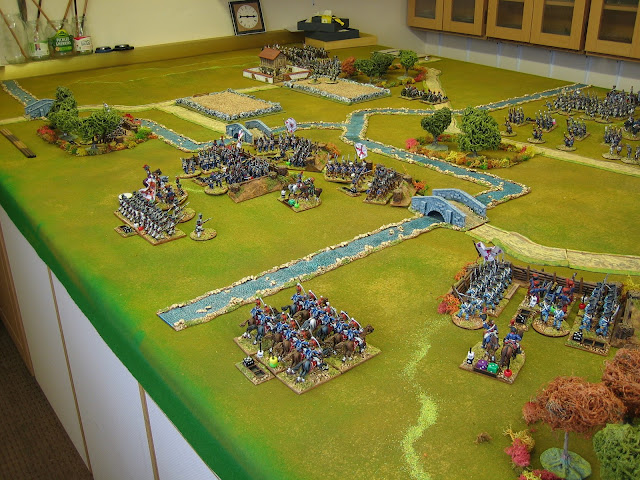So the campaign continued with map moves and it wasn't long before the End of Turn card reappeared. However, this time we had gone through about 60% of the cards before it did. The campaign activation deck was shuffled and we moved into turn 6. This released lots of UI from hospitals.
MacDonald activated. He moved from Barcelona to threaten O'Donnel in Terragona. O'Donnel retreated into the fortress and MacDonald moved to besiege him there. To show a siege is in progress we moved their pins into the siege holding box #1 and moved the siege pin #1 onto the map.Extreme Weather (extremely hot) came into effect in Aragon.
Freire activated, showed his heals to Suchet (departing Sarrion on a forced march card) to reach Tortosa in an attempt to relieve O'Donnel, at Teragona. He made the distance (4 nodes) but failed to initiate a battle.
The British failed to draw an event card.
Soult / MacDonald drew an event card - an important one.
Spanish Drafts: This was the card Peter probably most wanted and he recruited new drafts (in some numbers) to three of his armies, including O'Donnel.
Beresford activated but refused to move from the environs of Elvas.
MacDonald activated, again! He played his newly drawn event card: Siege Artillery. He ordered an assault on Terragona: No external reinforcements by concentration allowed. It would be 44 French infantry UI versus 28 Spanish infantry UI, both with their consequent supporting assets.
Because of the way the game ended last week (with insufficient time to do a new set of campaign map moves) it was agreed that I would pre-set a terrain for the next battle: Not knowing who would fight on it or where, this seemed fair enough - the exact terrain effect definitions could be sorted out after discovering which type of terrain (open, mountain, or wooded/cultivated) would be appropriate for the battle - I set up something that could cover all of the bases.
We spent the next hour or so working out the exact OOBs and Peter's fortifications (which he gets for defending in a siege assault game), then we deployed - Spanish first. With perhaps an hour of the evening still to go we decided to call the session over so people could get an early night. We are set for a full evening of table-gaming next week. This shot shows the Spanish deployment looking from the right, with a redoubt on high ground holding that flank of the position.On the Spanish left Cazadores hold a Fleche in a wood.
The strongly held centre. Two fleches supported by a redoubt on high ground immediately behind.
Two batteries cited for maximum field of fire and within range of all the defences of the Spanish centre and left wing.
The French right - a mixed force of infantry and cavalry.
Secondly, I give you the Voluntarios de Navarra. I have these wearing the so called 'English Uniform'. They were wearing something similar late in the war (possibly with red lapels?); the grenadiers may have carried swords very similar to those carried by their French counterparts, mine don't. However, as the last infantry unit in the Napoleonic lead pile, these are close enough.












5 comments:
The Cazadores holding the flèche look a tough nut to crack , but then all the fortifications are formidable. It’s great to see a Spanish Army on the table with a realistic chance of prevailing, but that’s the beauty of a Campain . Looks like a cracking game coming up , a just reward for all your hard work , James . 👍
Defending a fortified position to the death seems the Spanish forte - I have high hopes. Is the river fordable?
The river causes a move reduction and disorder. Unless there is a major (campaign map) river that's what all random table-top rivers do.
Why would you take a straight fortification when you could get a fleche for the same points? It's got better field of fire and......no drawbacks?
Where did your rivers come from? Self made vs purchased?
Troops in a fleche have a NC (no change) modifier for fire. A simple fortification gives an Up 1 modifier to fire. In a string, you would probably have 'simple' between 'fleche/redoubts'.
Post a Comment